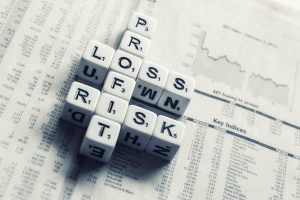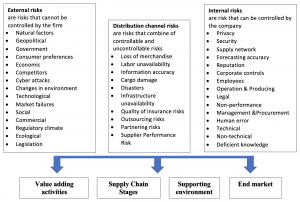7.3 Types of Risks and Disruptions
Learning Objective
2. Identify types of risks and disruptions
Figure 7.2
Dice
 Note. Dice with letters arranged to form words: profit, loss, risk. From AbsolutVision, 2017. Pixabay Licence
Note. Dice with letters arranged to form words: profit, loss, risk. From AbsolutVision, 2017. Pixabay Licence
Risk is a possibility of an event that can occur and affect the global value chain. There are different types of risks: external and internal, and distribution channel risks. These risks can be predictable, unpredictable, controllable, uncontrollable, technical, non-technical. Some of them combine a few criteria, such as predictable and uncontrollable or unpredictable and uncontrollable. External risks are risks that the firm cannot control and often are difficult to influence. Therefore, they require a complex approach and try to identify and mitigate them.
According to the FITT (2013), external risks can be predictable and uncontrollable such as cost fluctuations, market risks, inflation, environmental, operational, taxation. In addition, external risks can be unpredictable, such as natural hazards and sabotage, which are uncontrollable (FITT, 2013). Internal risks are risks that the company can control, and they are technical and non-technical. These risks are controllable because the organization can eliminate or avoid them. For example, non-technical internal risks are human error, management, delays, inappropriate procurement, or loss of profits (FITT, 2013). Non-technical risks are related to the interactions between stakeholders such as the public, government, regulatory, partners, contractors, communities. Technical internal risks consist of risks associated with technology and design issues. These risks impact the following parts of the organizational model of the global value chain: value-adding activities, supply chain stages, supporting environment, and end markets such as buyer, producer, or geographic market (Smorodinskaya et al., 2021).
Risks in the global value chain significantly influence domestic and international companies and the environmental organizations overall.
The most identified risks in the global value chain are political, accidents, natural disasters, product integrity, physical supply security (theft), cybersecurity, financial supply chain, performance risks (Supply Chain Risk, 2020, February 18). CC-BY-SA-4.0
Figure 7.3
Supply Chain Risks

Additionally, a stable political environment helps businesses flourish and maintain long-term plans because of a business-friendly political environment. A great source of checking a country’s political stability is Global Economy.com (2022). For example, the strongest indicator of the politically stable countries is Liechtenstein, Andorra, New Zealand, and Singapore, while the weakest are Syria, Afghanistan, Yemen, and Iraq. The lowest countries are often developing countries with more extreme instability caused by civil wars, corruption, turmoil, or protectionism. Firms have no control over politically unstable countries and their problems that can cause disruptions within the global value chain. Moreover, companies often cannot operate within the country during a difficult time, and they often lose permission or lose business.
Please explore the Global Economy website.
Video: Container Vessel Collision in Karachi Port (1:24)
Traffic at the South Asia Port Terminal Limited (SAPT) was suspended after two ships reportedly collided at the Karachi port here on Monday.
Media 7.2 Container Vessel Collision in Karachi Port. [Video]. Heavy Lift Specialist.
Video: Aftermath of Explosion at Beirut Port (4:27)
A view of damaged buildings in the Gemmayzeh neighborhood of Beirut on Aug. 13, 2020. The explosion at Beirut’s port last week killed over 170 people, injured thousands and upended uncounted lives.
Media 7.3 Aftermath of Explosion at Beirut Port. [Video]. Los Angeles Times.
Video: What Really Happened at the Suez Canal? (11:33)
Exploring the engineering principles behind the recent obstruction of the Suez Canal, which caused a weeklong disruption in global shipping traffic. I give a brief overview of the bank effect and dilatancy of coarse-grained soils. Hopefully, the video helps you understand a few of the engineering challenges associated with navigating massive ships through tiny canals and what can happen when they run aground!
Media 7.4 What Really Happened at the Suez Canal? [Video]. Practical Engineering.
Video: Coronavirus Outbreak: The Impact COVID-19 is Having on the Global Economy (4:55)
In an effort to flatten curve of the COVID-19 pandemic the world has been forced to come to a standstill. Streets are empty, shops are closed and people are out of work, public gatherings have been banned in many places and travel restrictions have been imposed. And all of this is having a major impact on the global economy. The United Nations says we may see a $2 trillion shortfall in our global income and a $220 billion hit to developing countries because of COVID-19.
Media 7.5 Coronavirus Outbreak: The Impact COVID-19 is Having on the Global Economy. [Video]. Global News.
Video: Explosion in China Which Could Be Seen From Space (9:54)
In China an explosion devastated the port of Tianjin, near Beijing. The blast was large enough to be seen from space and registered as 2.9 on the earthquake scale but how did an explosion that detonated with the force of over 300 tonnes on TNT happen?
Media 7.6 Explosion In China Which Could Be Seen From Space | Disasters Engineered. [Video]. Quest TV.
Consider This: Supply Chain Risk Management
The following material is adapted from Supply Chain Risk Management: Literature Review by Amulya Gurtu & Jestin Johny under Creative Commons Attribution License 4.0.
Additionally, risks cause disruption, which ripples through the network of the supply chains. Supply Chain Risk Management [SCRM] ensures the smooth functioning of supply chains. Risk can be termed as vulnerability, uncertainty, disruption, disaster, peril, or hazard. A lack of foresight about a likely disruption in a supply chain and its causes makes a supply chain vulnerable, and the SCM leaders less effective.
SCRM can be divided into two broad categories of approaches. The first is the strategy for a comprehensive risk management approach, and the second is a focused approach to a specific disruption. These specific disruptions could be security, lead times, or terrorism. For instance, Children’s toys contained lead-based paint in 2007 without the knowledge of Mattel. This caused disruptions in Mattel’s supply chains. Mattel ended up setting quality assurance centres at the suppliers’ factories to avoid the repetition of the lead paint crisis. The supplier used lead-based paint to save small operational costs. The cost of disruption to Mattel was much more significant and could have been avoided.
Disruptions in supply chains are evolving to be more comprehensive and recurrent in the business environment. The scale and rate of risk events in supply network are increasing. Disruptions determine the robustness of SCM in a company. Disruption events are described as when “the tornado hits, the bomb explodes, a supplier goes out of business, or the union begins a wildcat strike” (Sheffi and Rice 2005). There are different types of risk identified by various academicians and practitioners from the field of SCM. The risk classified by various authors can be elaborated to include the scale and risk occurrence. Some other parameters to classify risks in SCM are: (i) based on the sources of risk and mitigation strategies (ii) as organizational risks, environmental risks, and network risks (iii) demand and supply risks (iv) industry and organizational risks, and (v) network risks.
An uncertain business environment causes supply chain risks. The uncertain business environment results from cyclical business behaviour, fluctuation in demands, or a disaster. Therefore, uncertainty may be seen as a risk that can disrupt supply chain performance. Some authors have categorized risks in supply chains under operational risk, network risk, and external risks. Operational risks are due to a strategic re-engineering failure arising from within the system. For example, a ferry named Moby Prince collided with a ship named Agip-Abruzzo in the Mediterranean Sea on 10 April 1991, causing a loss of 140 lives and 25,000 tons of oil; a fire in the Haven oil-tanker caused the loss of six lives, and 50,000 tons of oil on April 11, 1991. Network risks are derived from the supplier network layers based on the title, vendor strategies, and agreements between the supply chain network vendors. Thirdly, external risks result from an organization’s external environment, which poses a significant threat to the existing business environment. According to Silva and Reddy (2011), 73% of the U.S. organizations suffered more than USD 1 billion in sales in the previous five years due to volatile disruption in the business cycle, with the most recurrent disruption caused by unmanageable natural disasters. Such turmoil often immobilizes supply chains for an extended duration.
(Gurtu & Johny, 2021). CC-BY-4.0
A lack of foresight risks in the organization can cause disruptions. Disruptions can ripple through the global value chain, which causes vulnerability, uncertainty, and colossal loss of money. For example, during economic hardship, disturbances in the global value chain cost a lot for organizations. According to Statista (2021), an average 184 million US dollars per year costs organizations worldwide supply chain disruptions. The highest annual average cost in the United States accounted for 228 million US dollars. View graph Estimated average annual cost to respondents’ organizations as a result of global supply chain disruptions in 2021, by region or country. [Chart description].
Check Your Understanding
Identify types of risks and disruptions.
Answer the question(s) below to see how well you understand the topics covered above. You can retake it an unlimited number of times.
Use this quiz to check your understanding and decide whether to (1) study the previous section further or (2) move on to the next section.
Overall Activity Feedback
It is important to know that risk is a possibility of an event that can occur and affect the global value chain. There are different types of risks: external and internal, and distribution channel risks. These risks can be predictable, unpredictable, controllable, uncontrollable, technical, non-technical. Some of them combine a few criteria, such as predictable and uncontrollable or unpredictable and uncontrollable. External risks are risks that the firm cannot control and often are difficult to influence. Therefore, they require a complex approach and try to identify and mitigate them. According to Silva and Reddy (2011), 73% of the U.S. organizations suffered more than USD 1 billion in sales in the previous five years due to volatile disruption in the business cycle, with the most recurrent disruption caused by unmanageable natural disasters.
Media Attributions and References
AbsolutVision. (2017). Dice over newspaper. [Photograph]. Pixabay. https://pixabay.com/illustrations/dices-over-newspaper-profit-2656028/
Global News. (2020, April 9). Coronavirus outbreak: The impact COVID-19 is having on the global economy. [Video]. YouTube. https://www.youtube.com/watch?v=0cGLrSpaf4o
Heavy Lift Specialist. (2018, March 20). Container vessel collision in Karachi Port. [Video]. YouTube. https://www.youtube.com/watch?v=Y0OY9XrOLcs
Los Angeles Times. (2020, August 14). Aftermath of explosion at Beirut port. [Video]. YouTube. https://www.youtube.com/watch?v=BuTVd_jwRuw
Practical Engineering. (n.d.). What really happened at the Suez Canal? [Video]. YouTube. https://www.youtube.com/watch?v=Ty-m4pm8oog
Quest TV. (2021, April 1). Explosion In China which could be seen from space | Disasters engineered. [Video]. YouTube. https://www.youtube.com/watch?v=z39sNRK614U

